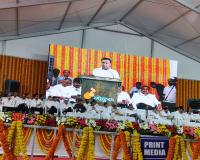- More
- Contactless touchscreen to help fight viruses; developed by Jagaur Land Rover
Contactless touchscreen to help fight viruses; developed by Jagaur Land Rover
Contactless touchscreen technology developed by Jaguar Land Rover and the University of Cambridge will help keep drivers’ eyes on the road and reduce the spread of bacteria and viruses in a post-COVID-19 world. The patented technology, known as ‛predictive touch’, uses artificial intelligence and sensors to predict a user’s intended target on the touchscreen – whether that’s satellite

Contactless touchscreen technology developed by Jaguar Land Rover and the University of Cambridge will help keep drivers’ eyes on the road and reduce the spread of bacteria and viruses in a post-COVID-19 world.
The patented technology, known as ‛predictive touch’, uses artificial intelligence and sensors to predict a user’s intended target on the touchscreen – whether that’s satellite navigation, temperature controls or entertainment settings – without touching a button.
The pioneering system, developed with engineers at the University of Cambridge, is part of Jaguar Land Rover’s Destination Zero vision – a desire to make its vehicles safer and the environment cleaner and healthier.
In the ‘new normal’ once lockdowns around the world are lifted, a greater emphasis will be placed on safe, clean mobility where personal space and hygiene will carry premiums. Jaguar Land Rover vehicles are already designed to help improve passenger wellbeing, with innovations including a Driver Condition Monitor, engine noise cancellation and cabin air ionisation with PM 2.5 filtration to capture ultrafine particles and allergens. New technology like predictive touch is another step forward as we address the wider landscape of mobility, from how customers connect with mobility services, to the infrastructure required to enable fully integrated, autonomous vehicles in our cities, like Project Vector.
Lab-tests and on-road trials showed the predictive touch technology could reduce a driver’s touchscreen interaction effort and time by up to 50 per cent, as well as limiting the spread of bacteria and viruses.
Uneven or poor road surfaces can often cause vibrations that make it difficult to select the correct button on a touchscreen. This means drivers must take their attention away from the road, increasing the risk of an accident.
The technology uses artificial intelligence to determine the item the user intends to select on the screen early in the pointing task, speeding up the interaction. A gesture tracker uses vision-based or radio frequency-based sensors, which are increasingly common in consumer electronics, to combine contextual information such as user profile, interface design and environmental conditions with data available from other sensors, such as an
eye-gaze tracker, to infer the user’s intent in real time.
ooo











